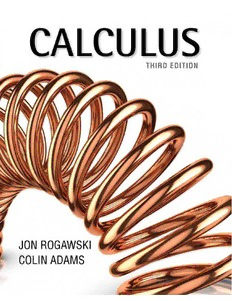
Calculus PDF
Preview Calculus
TOJULIE–Jon TOALEXAANDCOLTON–Colin Publisher:TerriWard DevelopmentalEditors:TonyPalermino,KatrinaWilhelm MarketingManager:CaraLeClair MarketDevelopmentManager:ShannonHoward ExecutiveMediaEditor:LauraJudge AssociateEditor:MarieDripchak EditorialAssistant:VictoriaGarvey DirectorofEditing,Design,andMediaProduction:TraceyKuehn ManagingEditor:LisaKinne ProjectEditor:KerryO’Shaughnessy ProductionManager:PaulRohloff CoverandTextDesigner:BlakeLogan IllustrationCoordinator:JaniceDonnola Illustrations:NetworkGraphicsandTechsetters,Inc. PhotoEditors:EileenLiang,ChristineBuese PhotoResearcher:EileenLiang Composition:JohnRogosich/Techsetters,Inc. PrintingandBinding:RRDonnelley Coverphoto:ayzek/Shutterstock LibraryofCongressPreassignedControlNumber:2014959514 InstructorComplimentaryCopy: ISBN-13:978-1-4641-9379-8 ISBN-10:1-4641-9379-7 Hardcover: ISBN-13:978-1-4641-2526-3 ISBN-10:1-4641-2526-0 Loose-leaf: ISBN-13:978-1-4641-9380-4 ISBN-10:1-4641-9380-0 ©2015,2012,2008byW.H.FreemanandCompany Allrightsreserved PrintedintheUnitedStatesofAmerica Firstprinting W.H.FreemanandCompany,41MadisonAvenue,NewYork,NY10010 Houndmills,BasingstokeRG216XS,England www.macmillanhighered.com ABOUT THE AUTHORS COLIN ADAMS ColinAdams is the Thomas T. Read professor of Mathematics at Williams College, wherehehastaughtsince1985.ColinreceivedhisundergraduatedegreefromMIT andhisPhDfromtheUniversityofWisconsin.Hisresearchisintheareaofknottheory and low-dimensional topology. He has held various grants to support his research, and writtennumerousresearcharticles. Colinistheauthororco-authorofTheKnotBook,HowtoAceCalculus:TheStreetwise Guide, How to Ace the Rest of Calculus: The Streetwise Guide, Riot at the Calc Exam andOtherMathematicallyBentStories,WhyKnot?,IntroductiontoTopology:Pureand Applied,andZombies&Calculus.Heco-wroteandappearsinthevideos“TheGreatPi vs.EDebate”and“Derivativevs.Integral:theFinalSmackdown.” He is a recipient of the Haimo National Distinguished Teaching Award from the MathematicalAssociationofAmerica(MAA)in1998,anMAAPolyaLecturerfor1998- 2000,aSigmaXiDistinguishedLecturerfor2000-2002,andtherecipientoftheRobert FosterCherryTeachingAwardin2003. Colin has two children and one slightly crazy dog, who is great at providing the entertainment. JON ROGAWSKI As a successful teacher for more than 30 years, Jon Rogawski listened and learned muchfromhisownstudents.Thesevaluablelessonsmadeanimpactonhisthinking, hiswriting,andhisshapingofacalculustext. Jon Rogawski received his undergraduate and master’s degrees in mathematics si- multaneouslyfromYaleUniversity,andheearnedhisPhDinmathematicsfromPrinceton University,wherehestudiedunderRobertLanglands.BeforejoiningtheDepartmentof MathematicsatUCLAin1986,wherehewasafullprofessor,heheldteachingandvisiting positionsattheInstituteforAdvancedStudy,theUniversityofBonn,andtheUniversity ofParisatJussieuandOrsay. Jon’sareasofinterestwerenumbertheory,automorphicforms,andharmonicanaly- sisonsemisimplegroups.Hepublishednumerousresearcharticlesinleadingmathemat- icsjournals,includingtheresearchmonographAutomorphicRepresentationsofUnitary GroupsinThreeVariables(PrincetonUniversityPress).HewastherecipientofaSloan Fellowship and an editor of the Pacific Journal of Mathematics and theTransactions of theAMS. Sadly,JonRogawskipassedawayinSeptember2011.Jon’scommitmenttopresent- ingthebeautyofcalculusandtheimportantroleitplaysinstudents’understandingofthe widerworldisthelegacythatlivesonineachneweditionofCalculus. CONTENTS CALCULUS Chapter 1 PRECALCULUS REVIEW 1 5.4 TheFundamentalTheoremofCalculus,PartI 254 5.5 TheFundamentalTheoremofCalculus,PartII 259 1.1 RealNumbers,Functions,andGraphs 1 5.6 NetChangeastheIntegralofaRateofChange 264 1.2 LinearandQuadraticFunctions 12 5.7 SubstitutionMethod 270 1.3 TheBasicClassesofFunctions 19 ChapterReviewExercises 277 1.4 TrigonometricFunctions 23 1.5 Technology:CalculatorsandComputers 32 Chapter 6 APPLICATIONS OF THE INTEGRAL 281 ChapterReviewExercises 36 6.1 AreaBetweenTwoCurves 281 Chapter 2 LIMITS 39 6.2 SettingUpIntegrals:Volume,Density,AverageValue 289 6.3 VolumesofRevolution 299 2.1 Limits,RatesofChange,andTangentLines 39 6.4 TheMethodofCylindricalShells 307 2.2 Limits:ANumericalandGraphicalApproach 47 6.5 WorkandEnergy 313 2.3 BasicLimitLaws 56 ChapterReviewExercises 319 2.4 LimitsandContinuity 59 2.5 EvaluatingLimitsAlgebraically 68 Chapter 7 EXPONENTIAL FUNCTIONS 321 2.6 TrigonometricLimits 73 2.7 LimitsatInfinity 78 7.1 Derivativeoff(x) bx andtheNumbere 321 = 2.8 IntermediateValueTheorem 84 7.2 InverseFunctions 329 2.9 TheFormalDefinitionofaLimit 87 7.3 LogarithmsandTheirDerivatives 336 ChapterReviewExercises 94 7.4 ExponentialGrowthandDecay 345 7.5 CompoundInterestandPresentValue 351 Chapter 3 DIFFERENTIATION 97 7.6 ModelsInvolvingy′ k(y b) 356 = − 7.7 L’Hôpital’sRule 361 3.1 DefinitionoftheDerivative 97 7.8 InverseTrigonometricFunctions 368 3.2 TheDerivativeasaFunction 105 7.9 HyperbolicFunctions 376 3.3 ProductandQuotientRules 117 ChapterReviewExercises 386 3.4 RatesofChange 123 3.5 HigherDerivatives 132 Chapter 8 TECHNIQUES OF INTEGRATION 391 3.6 TrigonometricFunctions 137 3.7 TheChainRule 141 8.1 IntegrationbyParts 391 3.8 ImplicitDifferentiation 148 8.2 TrigonometricIntegrals 397 3.9 RelatedRates 155 8.3 TrigonometricSubstitution 405 8.4 IntegralsInvolvingHyperbolicandInverseHyperbolic ChapterReviewExercises 162 Functions 411 Chapter 4 APPLICATIONS OF THE DERIVATIVE 167 8.5 TheMethodofPartialFractions 416 8.6 StrategiesforIntegration 424 4.1 LinearApproximationandApplications 167 8.7 ImproperIntegrals 432 4.2 ExtremeValues 174 8.8 ProbabilityandIntegration 443 4.3 TheMeanValueTheoremandMonotonicity 184 8.9 NumericalIntegration 450 4.4 TheShapeofaGraph 190 ChapterReviewExercises 459 4.5 GraphSketchingandAsymptotes 197 4.6 AppliedOptimization 204 Chapter 9 FURTHER APPLICATIONS OF THE 4.7 Newton’sMethod 216 INTEGRAL AND TAYLOR ChapterReviewExercises 221 POLYNOMIALS 463 Chapter 5 THE INTEGRAL 225 9.1 ArcLengthandSurfaceArea 463 9.2 FluidPressureandForce 470 5.1 ApproximatingandComputingArea 225 9.3 CenterofMass 476 5.2 TheDefiniteIntegral 237 9.4 TaylorPolynomials 485 5.3 TheIndefiniteIntegral 247 ChapterReviewExercises 496 iv CONTENTS v Chapter 10 INTRODUCTION TO DIFFERENTIAL 15.3 PartialDerivatives 773 EQUATIONS 499 15.4 DifferentiabilityandTangentPlanes 783 15.5 TheGradientandDirectionalDerivatives 790 10.1 SolvingDifferentialEquations 499 15.6 TheChainRule 803 10.2 GraphicalandNumericalMethods 507 15.7 OptimizationinSeveralVariables 811 10.3 TheLogisticEquation 515 15.8 LagrangeMultipliers:OptimizingwithaConstraint 825 10.4 First-OrderLinearEquations 519 ChapterReviewExercises 834 ChapterReviewExercises 525 Chapter 16 MULTIPLE INTEGRATION 837 Chapter 11 INFINITE SERIES 529 16.1 IntegrationinTwoVariables 837 11.1 Sequences 529 16.2 DoubleIntegralsoverMoreGeneralRegions 848 11.2 SumminganInfiniteSeries 539 16.3 TripleIntegrals 861 11.3 ConvergenceofSerieswithPositiveTerms 550 16.4 IntegrationinPolar,Cylindrical,andSpherical 11.4 AbsoluteandConditionalConvergence 559 Coordinates 872 11.5 TheRatioandRootTestsandStrategiesforChoosing 16.5 ApplicationsofMultipleIntegrals 882 Tests 564 16.6 ChangeofVariables 894 11.6 PowerSeries 569 ChapterReviewExercises 907 11.7 TaylorSeries 579 ChapterReviewExercises 591 Chapter 17 LINE AND SURFACE INTEGRALS 911 Chapter 12 PARAMETRIC EQUATIONS, POLAR 17.1 VectorFields 911 COORDINATES, AND CONIC 17.2 LineIntegrals 921 SECTIONS 595 17.3 ConservativeVectorFields 935 17.4 ParametrizedSurfacesandSurfaceIntegrals 946 12.1 ParametricEquations 595 17.5 SurfaceIntegralsofVectorFields 960 12.2 ArcLengthandSpeed 606 ChapterReviewExercises 970 12.3 PolarCoordinates 612 12.4 AreaandArcLengthinPolarCoordinates 620 Chapter 18 FUNDAMENTAL THEOREMS OF 12.5 ConicSections 625 VECTOR ANALYSIS 973 ChapterReviewExercises 638 18.1 Green’sTheorem 973 Chapter 13 VECTOR GEOMETRY 641 18.2 Stokes’Theorem 987 18.3 DivergenceTheorem 997 13.1 VectorsinthePlane 641 ChapterReviewExercises 1009 13.2 VectorsinThreeDimensions 651 13.3 DotProductandtheAngleBetweenTwoVectors 661 APPENDICES A1 13.4 TheCrossProduct 669 A. TheLanguageofMathematics A1 13.5 Planesin3-Space 680 B. PropertiesofRealNumbers A7 13.6 ASurveyofQuadricSurfaces 686 C. InductionandtheBinomialTheorem A12 13.7 CylindricalandSphericalCoordinates 694 D. AdditionalProofs A16 ChapterReviewExercises 701 ANSWERSTOODD-NUMBEREDEXERCISES ANS1 Chapter 14 CALCULUS OF VECTOR-VALUED REFERENCES R1 FUNCTIONS 705 INDEX I1 14.1 Vector-ValuedFunctions 705 14.2 CalculusofVector-ValuedFunctions 713 Additional content can be accessed online via LaunchPad: 14.3 ArcLengthandSpeed 722 14.4 Curvature 727 ADDITIONALPROOFS 14.5 Motionin3-Space 738 14.6 PlanetaryMotionAccordingtoKeplerandNewton 747 • L’Hôpital’sRule ChapterReviewExercises 753 ErrorBoundsforNumericalIntegration • ComparisonTestforImproperIntegrals • Chapter 15 DIFFERENTIATION IN SEVERAL VARIABLES 755 ADDITIONALCONTENT 15.1 FunctionsofTwoorMoreVariables 755 SecondOrderDifferentialEquations • 15.2 LimitsandContinuityinSeveralVariables 766 ComplexNumbers • PREFACE ABOUT CALCULUS On Teaching Mathematics Iconsidermyselfveryluckytohaveacareerasateacherandpractitionerofmathematics. WhenIwasyoung,IdecidedIwantedtobeawriter.Ilovedtellingstories.ButIwasalso goodatmath,and,onceincollege,itdidn’ttakemelongtobecomeenamoredwithit.I lovedthefactthatsuccessinmathematicsdoesnotdependonyourpresentationskillsor yourinterpersonalrelationships.Youareeitherrightoryouarewrongandthereislittle subjectiveevaluationinvolved.AndIlovedthesatisfactionofcomingupwithasolution. ThatintensifiedwhenIstartedsolvingproblemsthatwereopenresearchquestionsthat hadpreviouslyremainedunsolved. So,Ibecameaprofessorofmathematics.AndIsoonrealizedthatteachingmathe- maticsisabouttellingastory.Thegoalistoexplaintostudentsinanintriguingmanner,at therightpace,andinasclearawayaspossible,howmathematicsworksandwhatitcan doforyou.Ifindmathematicsimmenselybeautiful.Iwantstudentstofeelthatway,too. On Writing a Calculus Text IhadalwaysthoughtImightwriteacalculustext.Butthatisadauntingtask.Thesedays, calculus books average over a thousand pages. And I would need to convince myself thatIhadsomethingtoofferthatwasdifferentenoughfromwhatalreadyappearsinthe existingbooks.Then,IwasapproachedaboutwritingthethirdeditionofJonRogawski’s calculus book. Here was a book for which I already had great respect. Jon’s vision of whatacalculusbookshouldbefitverycloselywithmyown.Jonbelievedthatasmath teachers,howwesayitisasimportantaswhatwesay.Althoughheinsistedonrigorat alltimes,healsowantedabookthatwaswritteninplainEnglish,abookthatcouldbe readandthatwouldenticestudentstoreadfurtherandlearnmore.Moreover,Jonstrived tocreateatextinwhichexposition,graphics,andlayoutwouldworktogethertoenhance allfacetsofastudent’scalculusexperience. Inwritinghisbook,Jonpaidspecialattentiontocertainaspectsofthetext: 1. Clear,accessibleexpositionthatanticipatesandaddressesstudentdifficulties. 2. Layoutandfiguresthatcommunicatetheflowofideas. 3. Highlightedfeaturesthatemphasizeconceptsandmathematicalreasoning:Conceptual Insight,GraphicalInsight,AssumptionsMatter,Reminder,andHistoricalPerspective. 4. Arich collection of examples and exercises of graduated difficulty that teach basic skills,problem-solvingtechniques,reinforceconceptualunderstanding,andmotivatecal- culusthroughinterestingapplications.Eachsectionalsocontainsexercisesthatdevelop additionalinsightsandchallengestudentstofurtherdeveloptheirskills. Comingintotheprojectofcreatingthethirdedition,Iwassomewhatapprehensive. Herewasanalreadyexcellentbookthathadattainedthegoalssetforitbyitsauthor.First and foremost, I wanted to be sure that I did it no harm. On the other hand, I have been teaching calculus now for 30 years, and in that time, I have come to some conclusions aboutwhatdoesanddoesnotworkwellforstudents. As a mathematician, I want to make sure that the theorems, proofs, arguments and development are correct. There is no place in mathematics for sloppiness of any kind. Asateacher,Iwantthematerialtobeaccessible.Thebookshouldnotbewrittenatthe mathematicalleveloftheinstructor.Studentsshouldbeabletousethebooktolearnthe material,withthehelpoftheirinstructor.WorkingfromthehighstandardthatJonset,I havetriedhardtomaintainthelevelofqualityofthepreviouseditionwhilemakingthe changesthatIbelievewillbringthebooktothenextlevel. vi
